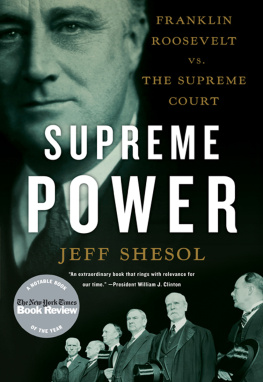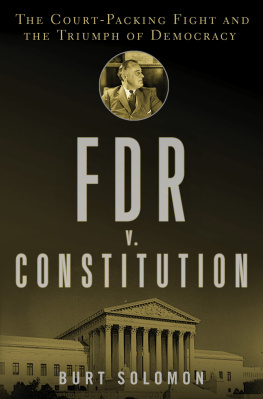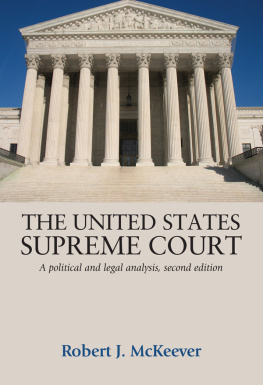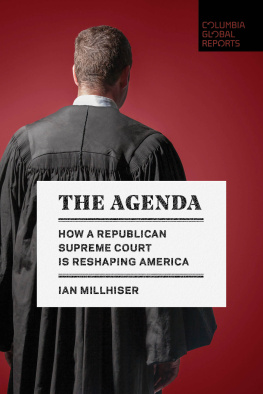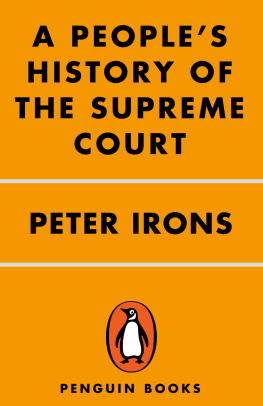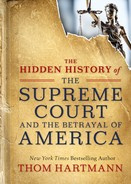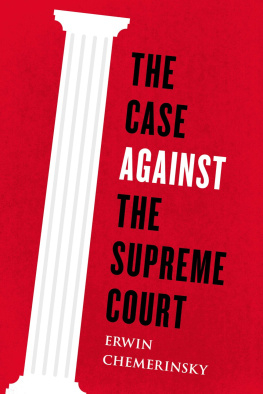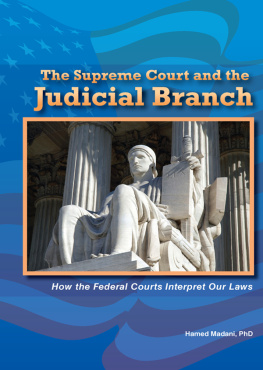FRANKLIN ROOSEVELT vs. THE SUPREME COURT
W. W. NORTON & COMPANY
Shesol, Jeff.
Supreme power: Franklin Roosevelt vs. the
Supreme Court / Jeff Shesol.1st ed.
p. cm.
Includes bibliographical references.
ISBN: 978-0-393-07941-8
1. United States. Supreme CourtHistory20th century.
2. Political questions and judicial powerUnited States
History20th century. 3. United StatesPolitics and
government20th century. 4. Roosevelt, Franklin D.
(Franklin Delano), 18821945Political and social views.
I. Title.
KF8742.S495 2010
347.73'2609dc22
W. W. Norton & Company, Inc.
500 Fifth Avenue, New York, N.Y. 10110
www.wwnorton.com
W. W. Norton & Company Ltd.
Castle House, 75/76 Wells Street, London W1T 3QT
The Fathers of the Constitution studied nothing more than to secure the complete independence of the judiciary. The President was not permitted to remove the judges, nor Congress to diminish their salaries. One thing only was either forgotten or deemed undesirable, because highly inconvenient, to determine,the number of judges in the Supreme court. Here was a weak point, a joint in the courts armour through which a weapon might some day penetrate.
INTRODUCTION
T HE COCKTAILS WERE typically strong, and tonight they felt like fortification.
The president himself had mixed the drinks, a custom he fulfilled with a practiced carelessness. But on this nightFebruary 2, 1937neither his tranquil air nor his potent drinks did much to dispel the unease among his aides, who gathered in his small private study, upstairs at the White House.
Franklin Roosevelt raised a glass to the Supreme Courtthe Court as it was, and the Court as he hoped it would be soon. The time for action, Roosevelt told the group, had come; their confrontation with the Court could no longer be postponed. Unpleasant as it is, I think we have to face it. These advisers, for thirty-six more hours, were the only men in America who could know precisely what this meantwhich accounted for their sense of foreboding.
A journalist once called Roosevelt apparently the least worried man in the country tonight, he was the least worried man in the room. He mimicked the morose expressions of his aides, who were not at all looking forward to the evening ahead, an annual dinner to honor the Supreme Court justices. Yet the president was clearly relishing the fact that, at that very moment, seven of the Courts Nine Old Men were arriving downstairs in the East Room, along with other protagonists in the national drama about to unfold.
Two weeks into his second term, Franklin Roosevelt stood at the pinnacle of power. He was the prevailing force, the predominant fact of American life. He had won, in November 1936, the biggest landslide in the nations history: a staggering 61 percent of the popular vote and nearly the entirety of the electoral college. His new and massive coalitionliberals, labor, women, and minoritiesgave him a mandate not simply to continue as president but to add expansively to the achievements of his first term. The nation was now closer to one-party rule than it had been since Reconstruction. During his first term, Roosevelt had enjoyed a comfortableand mostly compliantmajority on Capitol Hill. Now, at the start of his second, the imbalance of power was even more pronounced. In February 1937, the Senate contained seventy-six Democrats; the opposition, such as it was, totaled twenty, most but not all of them Republicans.
In Roosevelts view, the landslide enabled himat long lastto take on his most powerful, most implacable opponent, which he saw as the biggest impediment to social and economic progress in America: the United States Supreme Court.
By the time of Roosevelts second inaugural, in January 1937, the Supreme Courtin a series of devastating rulingshad left much of the New Deal in ruins. The centerpiece of Roosevelts first-term agenda was the National Recovery Administration (NRA), known by its symbol, the Blue Eagle, which appeared everywhere from shop windows to the costumes of chorus girls. On Black Monday, May 27, 1935, the Court struck it downrepudiating, by a stunning 90 vote, not just the program but its entire system of minimum wages, maximum hours, and workers rights. Next to fall was the pillar of the New Deals farm policy: the Agricultural Adjustment Act (AAA). Then the Guffey Coal Act. Then a state minimum-wage law. No Supreme Court in history had ever struck down so many laws so quickly. Between 1933 and 1936, the Court overturned acts of Congress at ten times the traditional rate. To accomplish this, justices disinterred long neglected doctrines and breathed new life into obscure clauses of the Constitution. The Court was creating new doctrine now faster than I can absorb it, complained Justice Harlan Fiske Stone, whose increasingly angry dissents made him a hero to New Dealers.
It was not just the number of adverse opinions but their stridency, their sweeping nature, that created an atmosphere of crisis in Washington. By 1937, the Courts majority had made amply clear that the very notion of the New Dealits use of governmental power to relieve the suffering caused by the Great Depression and to create a new and more just social and economic orderwas an affront to the Constitution, whether that power was exercised by the federal government or the states. The Court, Roosevelt complained to the press, had established a no-mans-land where no governmentstate or federalcan function. Social Security, soon to face the Courts scrutiny, seemed certain to fall, as did the National Labor Relations Act, as did just about everything of significance that Congress had passed or Roosevelt was likely to propose.
If reform was now impossible, so was recovery. Harold Ickes, Roosevelts Secretary of the Interior, thought that the president faced a very clear choice: curtail the Court or submit to judicial tyranny.
Roosevelt did not suppose that his triumph at the polls had in any way chastened the Court; the old maxim that the Court follows the election returns could not possibly apply to an institution that had been flouting, so consistently and flagrantly, the popular will. Indeed, the four or five most conservative justices, with every opinion they wrote against the New Deal, seemed almost to invite public outrage, to welcome it. The November landslide meant little to them. To Roosevelt, though, it meant the strength to strike backand quickly.
By the night of the Judiciary Dinner, all the pieces were in place. The plot had taken years to conceive. Its chief architect was the attorney general, Homer Cummings, who, at the presidents insistence, carried out his work covertly. No onenot Roosevelts Brain Trust, not his cabinetwas to know of the plan until the last possible moment.
The plan was this: to pack the Court.
Roosevelt would subdue the Courts conservatives by outnumbering them. In an audacious gambit, he would ask Congress to enlarge the Courts membership to fifteenadding, essentially overnight, up to six liberals to the bench. He would obscure this, his true goal, in trumped-up concerns about judicial performance, claiming that the nine old men in kimonos (as Will Rogers called them) were slow, infirm, and overwhelmed by their work.

